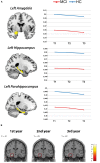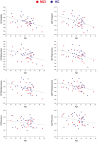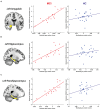Neuroanatomical and Neuropsychological Markers of Amnestic MCI: A Three-Year Longitudinal Study in Individuals Unaware of Cognitive Decline
- PMID: 28275349
- PMCID: PMC5320546
- DOI: 10.3389/fnagi.2017.00034
Neuroanatomical and Neuropsychological Markers of Amnestic MCI: A Three-Year Longitudinal Study in Individuals Unaware of Cognitive Decline
Abstract
Structural brain changes underlying mild cognitive impairment (MCI) have been well-researched, but most previous studies required subjective cognitive complaints (SCC) as a diagnostic criterion, diagnosed MCI based on a single screening test or lacked analyses in relation to neuropsychological impairment. This longitudinal voxel-based morphometry study aimed to overcome these limitations: The relationship between regional gray matter (GM) atrophy and behavioral performance was investigated over the course of 3 years in individuals unaware of cognitive decline, identified as amnestic MCI based on an extensive neuropsychological test battery. Region of interest analyses revealed GM atrophy in the left amygdala, hippocampus, and parahippocampus in MCI individuals compared to normally aging participants, which was specifically related to verbal memory impairment and evident already at the first measurement point. These findings demonstrate that GM atrophy is detectable in individuals with amnestic MCI despite unawareness of beginning cognitive decline. Thus, individuals with GM atrophy in regions associated with verbal memory impairment do not necessarily need to experience SCC before meeting neuropsychological criteria for MCI. These results have important implications for future research and diagnostic procedures of MCI.
Keywords: amygdala; gray matter atrophy; hippocampus; longitudinal; mild cognitive impairment; subjective cognitive complaints; voxel-based morphometry.
Figures



References
-
- Bondi M. W., Edmonds E. C., Jak A. J., Clark L. R., Delano-Wood L., Mcdonald C. R., et al. (2014). Neuropsychological criteria for mild cognitive impairment improves diagnostic precision, biomarker associations, and progression rates. J. Alzheimers Dis. 42 275–289. 10.3233/JAD-140276 - DOI - PMC - PubMed
LinkOut - more resources
Full Text Sources
Other Literature Sources
Research Materials

